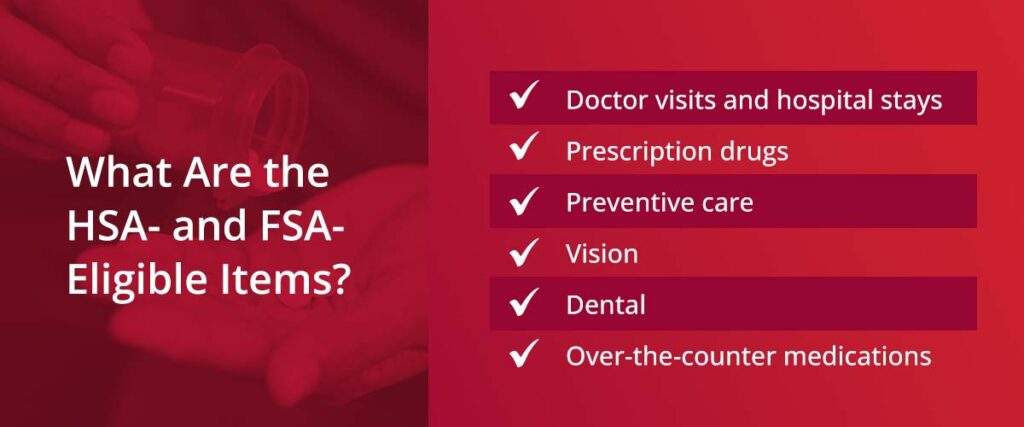
Health savings accounts (HSAs) and flexible spending accounts (FSAs) have significant advantages, but their features differ. Choosing between the two options or both requires careful consideration, which can be complex. This guide breaks down the relevant factors to help you make an informed decision.
Learn the rules of using HSAs and FSAs and which option is most suitable. Reach out to Accuplan Benefits Services for tailored support.
What Is a Health Savings Account?
An HSA is a tax-advantaged savings account that allows you to make pretax contributions to pay for qualified medical expenses. Employers may also contribute but are not required to do so. This account type is designed for individuals enrolled in high-deductible health plans (HDHPs) and has the following features:
- Tax advantages: Contributions can reduce taxable income, and earnings grow tax-free. You can also make tax-free withdrawals for qualified expenses.
- Rollover funds: You can roll over funds in the account year to year. This feature allows you to retain money you do not use in a given year, making HSAs beneficial for long-term savings.
- Qualified medical expenses: You can only use the funds for qualified expenses as defined by the IRS. These expenses include doctor visits, prescription drugs and hospital stays.
- Contribution limits: The IRS sets annual limits for individual and family coverage. These limits are adjusted periodically.
- Investment options: Some HSA providers offer investment options, allowing you to grow money beyond simple interest.
An HSA can be a powerful tool for saving on health care costs.
What Is a Flexible Spending Account?
An FSA is a benefit offered by some employers that lets you contribute pretax money from your paycheck to pay for eligible health care and dependant care expenses. Employers may also contribute, but there is no obligation. This arrangement lets you save on income tax, Social Security tax and potentially Medicare tax. Here are some essential features:
- Traditional plan requirement: FSAs are available to individuals with a conventional health plan.
- Eligibility: Eligibility depends on your employer’s benefit offering. Not all employees offer FSAs.
- Rollover of funds: FSAs apply the use-it-or-lose-it rule. You must use the funds within the plan year, or it will be forfeited.
- Contribution limits: The IRS sets annual contribution limits. You choose how much to contribute from your paycheck, but it must be within the limit.
- Reimbursement: You typically submit receipts for eligible expenses to your FSA administrator to receive reimbursement. The process varies depending on your employer’s plan.
FSAs can also be a valuable tool to save on health care and dependent care expenses.
HSAs vs. FSAs: Key Differences
Both HSAs and FSAs help manage health care expenses, but there are distinct features. Here are the main differences:
1. Contribution Limits and Rule
The IRS sets contribution limits for both HSAs and FSAs, but the amounts vary. For example, the FSA contribution limit for 2025 is $3,300, whereas the HSA contribution limits are $4,300 for individuals and $8,550 for family coverage. Again, unused HSA funds remain in the account and can be used in the future, but unused FSA funds are forfeited.
2. Eligibility Requirements
You must be enrolled in an HDHP to qualify for an HSA. Also, you should not be covered by another non-HDHP health plan or be enrolled in Medicare. Finally, you cannot be claimed as a dependent on someone else’s tax return.
In contrast, FSAs are generally available through employers, and their plan determines eligibility. Individuals whose employers offer FSAs can participate regardless of their health insurance plan.
3. Investment Options
Unlike an FSA, you can invest funds in your HSA. This feature allows you to grow your savings over time and benefit from compound returns. Also, funds in the HSA account belong to you whether you change plans, retire or leave your employer.
Can You Have an FSA and an HSA in the Same Year?
You cannot enroll in an HSA if you have a traditional FSA and vice versa. However, you can use an HSA and a limited-purpose FSA (LPFSA) at the same time. LPFSA is a type of FSA that allows reimbursement only for certain expenses, primarily dental and vision. It excludes expenses you would otherwise be eligible for under a standard FSA. Again, although vision and dental are eligible for LPFSA and HSA, you cannot use both accounts for the same expense. This practice is called double-dipping.
Some employers offer both HSAs and FSAs as part of their benefits package. They can also facilitate HSAs by offering HDHPs and contributing to the employee’s account.
What Are the HSA- and FSA-Eligible Items?
An IRS document called Publication 502 determines qualified expenses. These include:

- Doctor visits and hospital stays: These include co-pays and deductible expenses for medical care.
- Prescription drugs: Drugs prescribed by health care providers are typically HSA- and FSA-eligible expenses.
- Preventive care: You may use your HSA and FSA funds to pay for preventive care appointments and therapies.
- Vision: You can use your HSA and FSA funds to pay for eye exams, glasses, contact lenses and other related costs.
- Dental: HSA and FSA funds may cover dental needs, like fillings, cleanings and orthodontics.
- Over-the-counter medications: You may use HSA and FSA funds to cover over-the-counter costs.
Other eligible items are medical equipment, physical therapy and postpartum care.
Strategies for Maximizing Savings
Here are some tips to maximize savings on your HSA and LPFSA accounts:
- Use FSA funds first for eligible expenses: Considering LPFSA funds are forfeited at the end of the plan year, using those funds first is advisable. Preserving or investing your HSA funds can help with long-term growth.
- Plan for annual expenses: Anticipate your annual medical costs and allocate contributions accordingly. For example, if you expect significant dental or vision expenses, consider contributing to the LPFSA to cover those costs.
- Use HSA funds for large medical expenses: Tap into your HSA for larger medical expenses that exceed the FSA limit or occur later in the year after using your FSA. This strategy lets you benefit from the HSA’s tax-free growth.
It is crucial to implement plans that suit your health needs.
Should You Choose an FSA or an HSA?
Deciding between an FSA and an HSA depends on your financial goals, health care needs and employer offerings. Here is a breakdown of the key considerations:
1. Financial Goals
An FSA might be suitable if you prioritize saving on immediate expenses. You can contribute pretax dollars to cover anticipated medical costs in the current year. HSAs are ideal for long-term savings and investments. Unused funds roll over from year to year, accumulating tax-free growth over time.
2. Health Care Needs
An FSA can help manage predictable medical expenses, such as regular doctor visits and prescription medications. HSAs are suitable for unpredictable and potentially high medical expenses, like surgery and hospitalization. They provide more flexibility, higher contribution limits and tax-free growth.
3. Employer Offerings
Confirm if your employer offers an HSA-compatible HDHP since it is a prerequisite for contributing to an HSA. Secondly, check the types of FSAs your employer offers, whether general-purpose or limited-purpose FSA. Only an LPFSA is compatible with an HSA. Third, some employers contribute to employees’ HSAs and FSAs, enhancing your savings potential.
Open an HSA With Accuplan Benefits Services

Ready to maximize your health care savings and enjoy tax advantages? Open an HSA with Accuplan. With our HSA, you can plan your future and access funds anytime. Business account costs are low, with no charge for individual accounts. Contact us today to speak to one of our trusted professionals.
Our information shouldn’t be relied upon for investment advice but simply for information and educational purposes only. It is not intended to provide, nor should it be relied upon for accounting, legal, tax or investment advice.